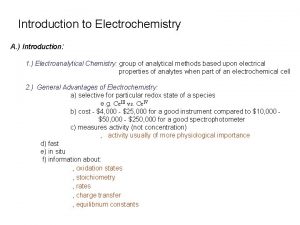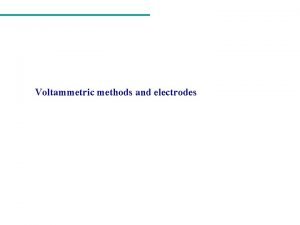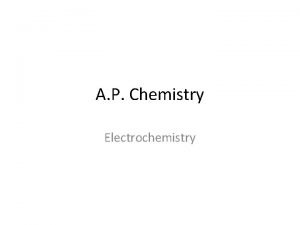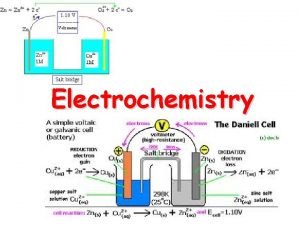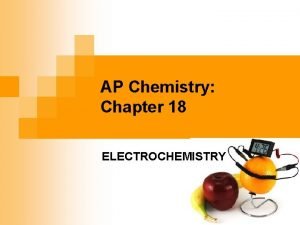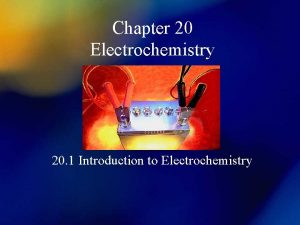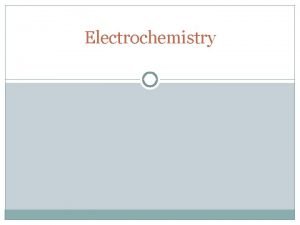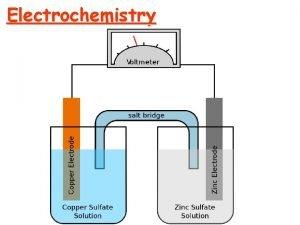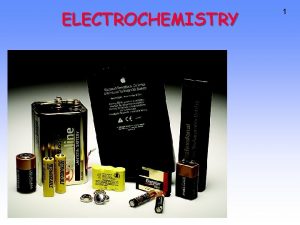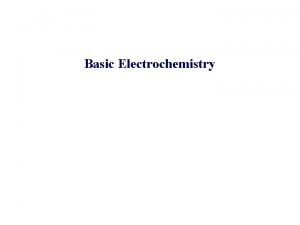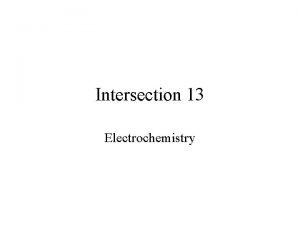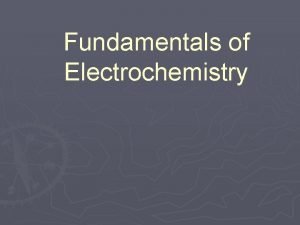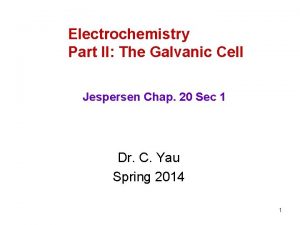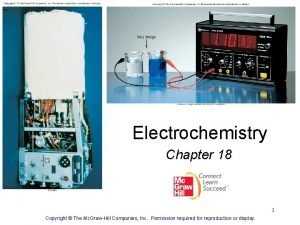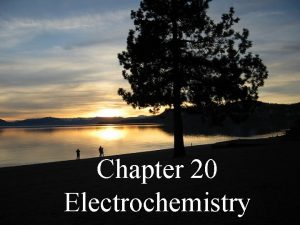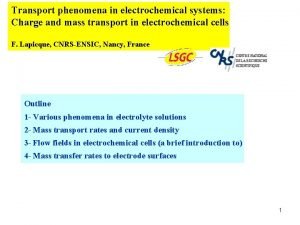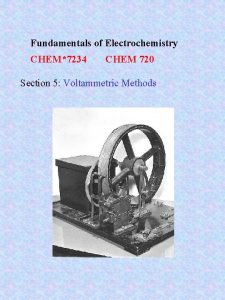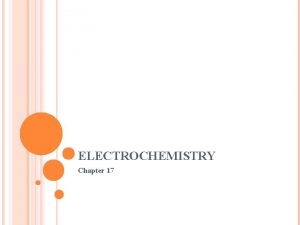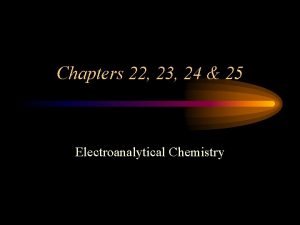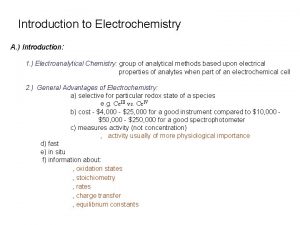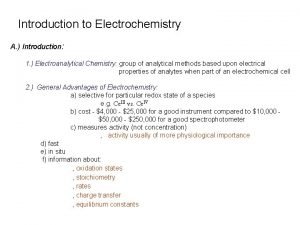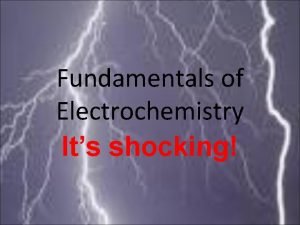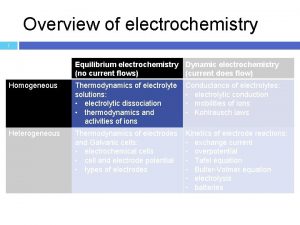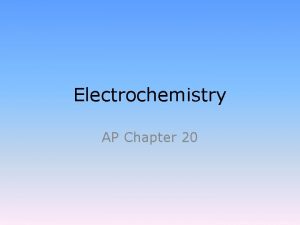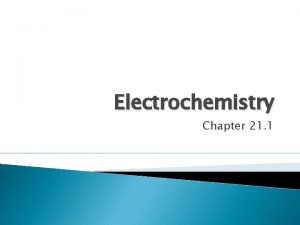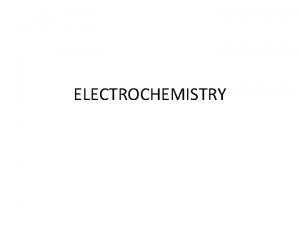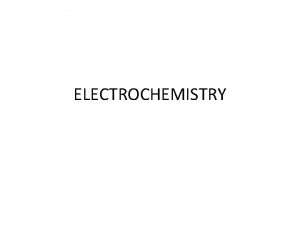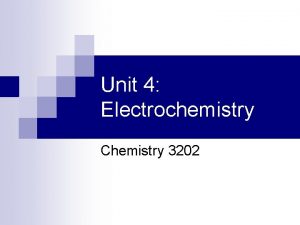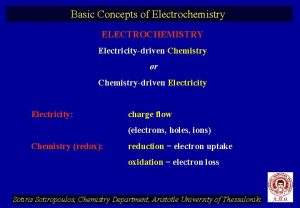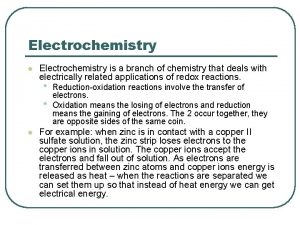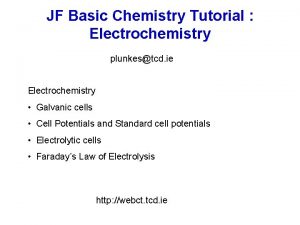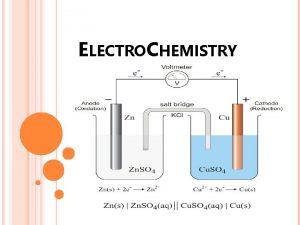Introduction to Electrochemistry A Introduction 1 Electroanalytical Chemistry













![By convention, ESHE = 0 V at [H+] = 1 M, PH 2 = By convention, ESHE = 0 V at [H+] = 1 M, PH 2 =](https://slidetodoc.com/presentation_image/49e9027904da1c570f7a18be14fef6bf/image-14.jpg)



















- Slides: 33

Introduction to Electrochemistry A. ) Introduction: 1. ) Electroanalytical Chemistry: group of analytical methods based upon electrical properties of analytes when part of an electrochemical cell 2. ) General Advantages of Electrochemistry: a) selective for particular redox state of a species e. g. Ce. III vs. Ce. IV b) cost - $4, 000 - $25, 000 for a good instrument compared to $10, 000 $50, 000 - $250, 000 for a good spectrophotometer c) measures activity (not concentration) ‚ activity usually of more physiological importance d) fast e) in situ f) information about: ‚ oxidation states ‚ stoichiometry ‚ rates ‚ charge transfer ‚ equilibrium constants

B. ) Types of Electroanalytical Methods

C. ) Electrochemical Cell: 1. ) Basic Set-up: a) Two electrodes b) electrolytes solution c) external connection between electrodes (wire) d) internal connection via contact with a common solution or by different solutions connected by a salt bridge – acts to isolate two halves of electrochemical cell while allowing migration of ions and current flow. - usually consists of a tube filled with potassium chloride - separate species to prevent direct chemical reactions

2. ) Flow of current (charge) in cell: a) electrons (e-) within wires between two electrodes b) ions within solution of each ½ cell (anions & cations) and through salt bridge c) electrochemical reactions at electrode electrons Cl- Zn 2+ SO 42 - At Cu electrode: Cu 2+ + 2 e- ↔ Cu(s) K+ Cu 2+ SO 42 - reduction – gain of e- net decrease in charge of species At Zn electrode: Zn(s) ↔ Zn 2+ + 2 e- oxidation – loss of e- net increase in charge of species

3. ) Net Reaction in Cell – sum of reactions occurring in the two ½ cells Zn(s) ↔ Zn 2+ + 2 e. Cu 2+ + 2 e- ↔ Cu(s) Cu 2+ + Zn(s) ↔ Zn 2+ + Cu(s) Potential of overall cell = measure of the tendency of this reaction to proceed to equilibrium at equilibrium, potential (Ecell) = 0 Larger the potential, the further the reaction is from equilibrium and the greater the driving force that exists Similar in concept to balls sitting at different heights along a hill

4. ) Types of Cells: Galvanic Cells – reaction occurs naturally - positive potential (Ecell = +) - exothermic produces energy Galvanic Cell

4. ) Types of Cells: Electrolytic Cells – reaction does not occur naturally, requires external stimulus (energy) to occur - negative potential (Ecell = -) - endothermic requires energy External battery at higher power than cell potential Electrolytic Cell Chemically Reversible Cell – a cell in which reversing the direction of the current simply reverses the chemical reaction

e- 5. ) Electrodes: a. ) Cathode – electrode where reduction occurs Anode – electrode where oxidation occurs b. ) Examples of cathode ½ reactions: Cu 2+ + 2 e- ↔ Cu(s) Fe 3+ + e- ↔ Fe 2+ Ag. Cl(s) + e- ↔ Ag(s) + Cl- e- supplied by electrical current via electrode - species (products/reactants) can both be in solution (Fe 3+/Fe 2+) solids or coated on electrodes (Ag. Cl(s)/Ag(s) or combination (Cu 2+/Cu(s) ec. ) Examples of anode ½ reactions: Cu(s) ↔ Cu 2+ + 2 e- Fe 2+ ↔ Fe 2+ + e. Ag(s) + Cl- ↔ Ag. Cl(s) + e- e- is taken up by electrode into electrical circuit

d. ) Liquid junctions – interface between two solutions with different components or concentrations Small potentials may develop at junction that affect overall cell potential Liquid Junction

d. ) Liquid junctions – interface between two solutions with different components or concentrations Galvanic cell without liquid junction - Two species have high potential for reaction, but the reaction is slow - mix two species directly into common solution - not common Bubble Hydrogen into a solution of Ag. Cl

e. ) Representation of Cells: by convention start with anode on left Phase boundary Electrode/solution interface anode oxidation Zn|Zn. SO 4(a. ZN 2+ = 0. 0100)||Cu. SO 4(a. Cu 2+ = 0. 0100)|Cu Solution in contact with anode & its concentration 2 liquid junctions due to salt bridge cathode reduction Solution in contact with cathode & its concentration

f. ) Electrode Potentials 1. ) for convenience, represent overall reaction in cell as two ½ reactions i. one at anode & other at cathode ii. each ½ reaction has certain potential associated with it iii. by convention, write both ½ reactions as reduction: Cu 2+ + 2 e- ↔ Cu(s) (Ecathode) Zn 2+ + 2 e- ↔ Zn(s) (-Eanode) iv. potential of cell is then defined as: Ecell = Ecathode – Eanode

f. ) Electrode Potentials 2. ) Problem – can not measure potential of just one electrode. i. need to compare to another electrode ii. determine potential of all ½ cell reactions vs. a common reference electrode iii. reference electrode – standard hydrogen electrode (SHE) Pt, H 2(p atm)|H+(a. H+ = x) 2 H+ + 2 e- ↔ H 2(g) stream of H 2 keeps surface at electrode saturated w/H 2(g) note: potential affected by p. H, [H+], used as an early p. H indicator, also dependent on PH 2
![By convention ESHE 0 V at H 1 M PH 2 By convention, ESHE = 0 V at [H+] = 1 M, PH 2 =](https://slidetodoc.com/presentation_image/49e9027904da1c570f7a18be14fef6bf/image-14.jpg)
By convention, ESHE = 0 V at [H+] = 1 M, PH 2 = 1 atm and at all temperatures Potentials of other electrodes are compared to SHE using electrode in question as cathode and SHE as anode: Mn+ + ne- ↔ M(s) Ecell = Ecathode – Eanode Ecell = Ecathode – ESHE By definition: Ecell = Ecathode – 0 Ecell = Ecathode

Standard Electrode Potential (Eo) – measured Ecell when all species in solution or gas has an activity of 1. 00 Activity (a) – proportional to molar concentration where: ax = gx[X] gx is the activity coefficient of solute X [X] is the molar concentration of solute X If Eo is “+”, it indicates that the reaction: Mn+ + n/2 H 2(g) ↔ M(s) + n. H+ is favored or spontaneous. Mn+ is readily reduced by H 2(g) Mn+ is better e- acceptor or oxidizing agent. If Eo is “-”, it indicates that the reaction is not favored or spontaneous and requires energy to proceed M(s) is readily oxidized by H+ M(s) is better e- donor or reducing agent.

As Eo increases oxidizing ability of ½ cell reaction increases Half-cell Potential (Eo) Al 3+ + 3 e- Al -1. 706 V Zn 2+ + 2 e- Zn -0. 763 V Cr 3+ + 3 e- Cr -0. 744 Fe 2+ + 2 e- Fe -0. 409 V Cd 2+ + 2 e- Cd -0. 401 V Ni 2+ + 2 e- Ni -0. 230 V Pb 2+ + 2 e- Pb -0. 126 V 2 H+ + 2 e- H 2 0. 00 V Ag. Cl + e- Ag + Cl- +0. 223 V Hg 2 Cl 2 + 2 e- 2 Hg + 2 Cl- +0. 268 V Cu 2+ + 2 e- Cu +0. 340 V Ag+ + e- Ag +0. 799 V Au+ + e- Au +1. 680 V Easily oxidized, Better Reducing Agent Easily reduced, Better Oxidizing Agent Reaction at Interface

Nernst Equation Values of Eelectrodes can also be calculated at other concentrations (activities) of species For ½ reaction: p. P + q. Q + … + ne- ↔ r. R +s. S + … products r s Eelectrode = E 0 - RTln (a. R) (a. S) … n. F (a. P)p(a. Q)q … reactants where: R = ideal gas law constant (8. 316 J mol-1 K-1) T = absolute temperature (K) - TK= 273. 15 + To. C n = number of electrons in process F = Faraday’s constant (96487 C mol-1) a = activities of each species (g[X]) - in solution at time of measurement - not necessarily at equilibrium y-intercept = E 0 slope = -(RT/n. F) (a. R)r (a. P)p

At room Temperature: RT n. F = 2. 5693 x 10 -2 V n Also, using log 10: NOTE: Calculation has to be done Twice!! 0. 0592 (a )r(a )s … log R p S q n (a. P) (a. Q) … electrode Eelectrode = E 0 - -Once for the anode -Once for the cathode electrode If know Eo, allows Eelectrode to be calculated under non-standard conditions. A very common mistake is to simply do the calculation once and report the Eelectrode as the Ecell o Note: If all activity values = 1, Eelectrode = E Once have Ecathode & -Eanode by above procedure, can also get Ecell: Ecell = Ecathode – Eanode **may need to also include junction potential, etc. , but good first approximation

Activity Coefficients - experimental determination of individual activity coefficients appears to be impossible - can determine mean activity coefficient (g"): electrolyte Am. Bn g" = (g. Amgn. B)1/(M+n) Debye-Huckel Equation where: ZA = charge on the species A c. A = concentration of species A m = ionic strength of solution a. A = the effective diameter of the hydrated ion Activity Coefficients at Indicated Ionic Strength Ion ax nm 0. 001 0. 005 0. 01 0. 05 0. 1 H 3 O+ 0. 967 0. 933 0. 914 0. 86 0. 83 Li+ 0. 6 0. 965 0. 929 0. 907 0. 84 0. 80 Na+ 0. 4 -0. 45 0. 964 0. 928 0. 902 0. 82 0. 78 Cl- 0. 3 0. 964 0. 925 0. 899 0. 80 0. 76 Note: At ionic strengths > 0. 1, Debye-Huckle Equation fails

An Example: Calculate Ecell for the Cell: Pt|H 2(1. 00 atm)|HCl (3. 215 x 10 -3 M), Ag. Cl (satd. )|Ag ½ cell reactions: Ag. Cl(s) + e- ↔ Ag(s) + Cl. H+ + e- ↔ ½ H 2(g) Eo = 0. 222 V (cathode) Eo = 0. 00 V (anode) Eo. Ag. Cl/Ag > Eo. H+/H 2 , so net reaction is spontaneous: Ag. Cl(s) + ½H 2 ↔ Ag(s) + H+ + Cl- Actual Potentials: Eelectrode = E 0 - 0. 0592 (a )r(a )s … log R p S q n (a. P) (a. Q) … Cathode Ecathode = E 0 Ag. Cl – (0. 0592/1) log acl- since satd. solids, activity of Ag. Cl and Ag = 1. Ecathode = E 0 Ag. Cl – 0. 0592 log gcl-[Cl-] Ecathode = 0. 222 V – 0. 0592 log(0. 939)(3. 215 x 10 -3 M 0. 939 Debye-Huckle equation m = 3. 215 x 10 -3 Cl- Ecathode = 0. 371 V

½ cell reactions: Ag. Cl(s) + e- ↔ Ag(s) + Cl- Eo = 0. 222 V (cathode) H+ + e- ↔ ½ H 2(g) Eo = 0. 00 V (anode) Ag. Cl(s) + ½H 2 ↔ Ag(s) + H+ + Cl- Actual Potentials: Anode Eanode = E 0 H+/H 2 – (0. 0592/1) log (a. H+)/(P 1/2 H 2) Eanode = E 0 H+/H 2 – 0. 0592 log (g. H+[HCl])/(P 1/2 H 2) Eanode = 0. 00 V – 0. 0592 log (0. 945)(3. 215 x 10 -3 M)/(1 atm)1/2 0. 945 Debye-Huckle equation m = 3. 215 x 10 -3 H+ Eanode = 0. 149 V Ecell = Ecathode – Eanode = 0. 371 V – 0. 149 V = 0. 222 V

6. ) Limitations in the Use of Standard Electrode Potentials (Eo): a. ) EO based on unit activities not concentrations - activity = concentration only in dilute solutions - at higher concentrations need to determine and use activity a. X = g. X[X] - example: Fe 3+ + e- ↔ Fe 2+ E 0 = +0. 771 V but E at 1 M is +0. 732 V, since g < 1 - problem if g not known from calculations or previous experimental studies b. ) Side Reactions can Affect Eo Apparent: - example: Fe 3+ + e- ↔ Fe 2+ E = +0. 73 V in 1 M HCl. O 4 Fe 3+ + e- ↔ Fe 2+ E = +0. 70 V in 1 M HCl Fe 3+ + e- ↔ Fe 2+ E = +0. 60 V in 1 M H 3 PO 4 - reason: Fe 2+ & Fe 3+ form different complexes with Cl- & PO 4 - that affects net activity of Fe 2+ and Fe 3+ in solution

7. ) Formal Potential (Ef or Eo’): - used to compensate for problems with Eo in using activity and with sidereactions - based on conditions of 1 M concentration with all species being specified e. g. HCl vs. HCl. O 4 as acid - gives better agreement than Eo with experimental data and Nernst Equation ‚ conditions need to be similar to conditions where Eo’ was measured 8. ) Reaction Rates: - some Eo ½ reactions listed in tables have been determined by calculations from equilibrium measurements rather than actual measurements of the ½ cell in an electrode system. e. g. 2 CO 2 + 2 H+ + 2 e- ↔ H 2 C 2 O 4 E 0 = -0. 49 V - problem ‚ reaction is slow and difficult to see in practice ‚ thermodynamics vs. kinetics ‚ no suitable electrode - potentially useful for computational purposes

9. ) Liquid Junction Potential - potential that develops whenever two electrolytes of different ionic composition come into contact - due to the unequal distribution of cations & anions across a boundary as a result of the differences in rates at which ions migrate. Both H+ & Cl- move from high to low concentration (entropy) H+ smaller and more mobile relative to Cl-, moves more quickly Results in separation of “+” and “-” charges and creation of potential Note: Equilibrium condition soon develops

- junction potential can be ³ 30 m. V ‚ for simple system can calculate if know mobility and concentration of all ions present - can decrease the junction potential by using salt bridge containing concentrated electrolyte ‚ best if mobility of ions are ~ equal ‚ 4 M KCl or KNO 3 ‚ decrease junction potential to £ few m. V

10. ) Currents in Electrochemical Cells a) Ohm’s Law E = IR where: E = potential (V, voltage) I = current (amps) R = resistance (ohms) > R depends on concentration and types of ions in solution < − Need high concentrations of supporting electrolytes (e. g. , KCl, Na. Cl for aqueous electrochemistry) − Electrolyte concentration is important in non-aqueous electrochemistry − Types of resistance in an electrochemical cell: mass transfer, charge transfer resistance, solution resistance, etc.

b) Mass Transport Resulting From Current in Bulk Solution - currents in solution are carried by movement of ions - again, small ions (H+) move faster and carry more current than larger ions (Cl-) - species reacting at electrode don’t have to be only species carrying current - example: ‚ if have much higher concentration of other ions (KCl or KNO 3), these will carry current in bulk solution ‚ analytes will carry current only in region near electrode surface

c) Currents at Electrode Surfaces i. ) Faradic ‚ transfer of e- to/from electrode by redox reactions ‚ governed by Faraday’s Law - amount of current is proportional to amount of species oxidized or reduced ii. ) Non-Faradic Current ‚ due to processes other than redox reactions at electrodes ‚ example – charging current - when first apply potential to electrode, get redistribution of ions near its surface to counter charge on electrode movement of ions = current - as system approaches equilibrium get decrease in ion movement and current Result of charging electrode is electric double layer by electrode surfaces. Electrode at this point is polarized.

11. ) Effect of Current on Cell Potential - potentials listed as Eo or Eo’ in Tables are Thermodynamic values ‚ at equilibrium, no current - in practice, some current is always present. - current causes ‚ decrease in measured potential (E) for galvanic cell ‚ increase in potential (E) needed to drive electrolytic cell Two Main Sources of Current Effects on Cell Potential: i. ) Ohmic Potential (IR drop) - flow of ions (current) through solution (resistance, R) gives potential across cell according to Ohm’s law E = IR - need to subtract from Ecell calculation to get “true” potential of the cell Ecell = Ecathode – Eanode -IR

ii. ) Polarization Effects - many electrochemical methods use current vs. potential curves Polarization effects contribute to the non-linear regions of curve Note: at high or low cell potential, get less “+” or “-” current than expected. – due to polarization ‚ solution or reaction can not keep up with changes in potential of system ‚ limits the rate of the overall reaction

Types of Polarization 1) Slow Mass Transfer = Concentration Polarization ‚ mass transfer due to: < diffusion concentration gradient < migration ions move in potential < convection mechanical stirring 2) Slow Intermediate Reactions = Reaction Polarization 3) Slow Transfer of Electron Between Electrode and Species = Charge. Transfer Polarization Any Combination of These Processes Can Be Present.

Overvoltage or Overpotential (h) - degree of polarization of an electrode - difference between actual electrode potential (E) and equilibrium potential (Eeq) h = E – Eeq where E < Eeq - polarization always reduces the electrode potential - h is always negative Overvoltage is sometimes useful: - high overvoltage associated with the formation of H 2 & O 2 from H 2 O - high h means takes much higher E than Eo to occur on many electrodes - can deposit metals without H 2 formation and interfering with electrodeposition process

Electrochemical Methods Learning Objectives: 1. Basic electrochemical cell setup. 2. Nernst equation 3. Electrochemical cell reactions and electrode potentials (galvanic cell, electrolytic cell) 4. Reference Cell 5. Indicator electrodes 6. Coulometry 7. Polarography (dropping mercury electrode) 8. Cyclic voltammetry
 Electroanalytical techniques
Electroanalytical techniques Electroanalytical
Electroanalytical Ap chemistry chapter 18 electrochemistry test
Ap chemistry chapter 18 electrochemistry test Ap chem electrochemistry
Ap chem electrochemistry What is electrochemistry in chemistry
What is electrochemistry in chemistry Electrochemistry is
Electrochemistry is Ap chemistry electrochemistry
Ap chemistry electrochemistry Introduction to electrochemistry
Introduction to electrochemistry Functional groups ib chemistry
Functional groups ib chemistry Organic vs inorganic chemistry
Organic vs inorganic chemistry Faraday's constant
Faraday's constant Hittorfs law
Hittorfs law Electrochemistry tutorial
Electrochemistry tutorial Electrochemistry equations
Electrochemistry equations Electrochemistry balancing equations
Electrochemistry balancing equations Electrochemistry stoichiometry
Electrochemistry stoichiometry Electrochemistry khan academy
Electrochemistry khan academy Basic electrochemistry
Basic electrochemistry Electrochemistry balancing equations
Electrochemistry balancing equations Ap chem electrochemistry review
Ap chem electrochemistry review Cell reaction in electrochemistry
Cell reaction in electrochemistry Chapter 21 electrochemistry
Chapter 21 electrochemistry E cell formula
E cell formula Electrochemistry eds
Electrochemistry eds Fundamentals of electrochemistry
Fundamentals of electrochemistry What is electrochemistry
What is electrochemistry Line notation electrochemistry
Line notation electrochemistry Diagonal rule electrochemistry
Diagonal rule electrochemistry Polarization in electrochemistry
Polarization in electrochemistry Electrochemistry lesson
Electrochemistry lesson Slidesdgo
Slidesdgo Mass transport electrochemistry
Mass transport electrochemistry Fundamentals of electrochemistry
Fundamentals of electrochemistry Electrochemistry
Electrochemistry
